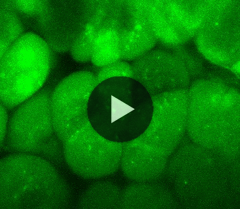Autophagy monitoring congenic strainsB6.B6D2-Tg(CAG-GFP/LC3)53Nmz/NmzRbrc (GFP-LC3#53) RBRC00806C.B6D2-Tg(CAG-GFP/LC3)53Nmz/Rbrc RBRC01413C3.B6D2-Tg(CAG-GFP/LC3)53Nmz/Rbrc RBRC01414MSM.B6D2-Tg(CAG-GFP/LC3)53Nmz/Rbrc RBRC01227  (avi file:12074KB/2s) A: B6.B6D2-Tg(CAG-GFP/LC3)53NmzRbrc (RBRC00806), a donor strain in the C57BL/6JJcl to generate other three congenic lines. |
Autophagy (Greek for “self-eating”) is known to have important roles in various physiological and pathological processes such as maintenance of the amino acid pool during starvation, preimplantation development, prevention of neurodegeneration, anti-aging, tumor suppression, clearance of intracellular microbes, and regulation of innate and adaptive immunity [1,2]. Accordingly, there is a growing need among scientists to be able to detect autophagy in vivo. The GFP-LC3#53 transgenic mouse is one of the most widely used in vivo autophagy monitoring tools and was developed by Dr. Noboru Mizushima [3]. This transgenic mouse enables the accurate detection of autophagosome in diverse biological processes. We have extended its capability to other useful inbred strains such as BALB/cAnN (RBRC00641), C3H/HeNCrlj, and MSM/MsRbrc (RBRC00209) by successive backcrossing. The genetic backgrounds of these strains were examined using simple sequence length polymorphism markers to assess congenic status. A genotyping protocol was also established to distinguish homozygous and hemizygous transgenic mice. These autophagy monitoring mice will be useful for assessing autophagy in various mouse disease models.
| What is autophagy? | : | http://www.cellcycle.m.u-tokyo.ac.jp/english/research/index.html |
| Depositor of donor strain: | : | Dr. Noboru Mizushima, Department of Biochemistry and Molecular Biology, The University of Tokyo |
| References | : | [1] | Mizushima N, Komatsu M. Autophagy: renovation of cells and tissues.Cell 147(4):728-741, 2011. |
| [2] | Mizushima N, Yoshimori T, Levine B.Methods in mammalian autophagy research.Cell 140(3):313-326, 2010. | ||
| [3] | Mizushima N, Yamamoto A, Matsui M, Yoshimori T, Ohsumi Y. In vivo analysis of autophagy in response to nutrient starvation using transgenic mice expressing a fluorescent autophagosome marker. Mol Biol Cell 15(3):1101-1111, 2004. |





